Museums and Exhibitions in New York City and Vicinity
| Home | | Museum Guide | | International | | Architecture & Design | | Theater |
GLENN LONEY'S MUSEUM NOTES
 |
| CLEVELAND MUSEUM TREASURES AT MORGAN--Piazetta's "Young Man Buying a Pink from a Young Woman." |
[01] Cleveland Master-Drawings at Morgan Library
[02] Frick Collection Shows Smith College Master-Drawings
[03] El Greco's 3 Jeromes & 4 Temples at the Frick
[04] New "Discovery Room" at American Museum of Natural History
[05] German Graphic Design at Bard Center
[06] Mies in Berlin at MoMA
[07] Mies in America at Whitney
[08] Frank Ghery's Plans & Projects at Guggenheim
[09] Salinas Prepares for John Steinbeck Centenary
You can use your browser's "find" function to skip to articles
on any of these topics instead of scrolling down. Click the "FIND" button or
drop down the "EDIT" menu and choose "FIND."
Copyright © 2001 Glenn Loney.
For a selection of Glenn Loney's previous columns, click here.
THE SUMMER OF MASTER-DRAWINGS ON MADISON—
Can this be an Elective Affinity?That two major New York museums with important collections of Master-Drawings have scheduled somewhat complementary exhibitions of similar treasures from far less well-known collections?
Whether this is mere serendipity—or careful planning—both shows suggest that visits to the home-museums of the wonderful drawings on loan would be well worthwhile.
The Cleveland Museum of Art Loans
Some Great Master Drawings to Morgan Library
[Closing August 19, 2001]

| |
| ALERTING MAYOR GIULIANI'S DECENCY-IN-ART COMMISSION!--Should our children be exposed to this Picasso "Reclining Nude" at the Morgan Library? | |
It's a very good thing Pablo Picasso did not title his "Reclining Nude" as "Virgin at Rest" instead. Had he been so thoughtless of religious sensibilities, Mayor Giuliani's Decency Commission might have intervened to prevent the showing of this impressive work.
Actually, neither the Mayor—who seems to have other things on his mind right now than art that is offensive to Roman Catholics—nor his divorce-lawyer & Decency Commissioner Raoul Felder have the power to meddle in matters at the Morgan.
It is not, as is the Brooklyn Museum, standing on city land, effectively "owned" by the city, nor subsidized by Muni Monies. J. P. Morgan was much too wise to turn his remarkable Library & Art Collection over to municipal oversight.
The closely hung sampling of the Cleveland Museum of Art's collection of drawings at the Morgan is so rich in technical virtuosity that each work demands close study.
Some of the early works offer Bible-Study on a very high level. For obvious reasons, early sketches often deal with religious subjects. As merchant-patrons began to emerge, bourgeoise images appeared to meet their cultural needs.
Only 120 drawings have been selected from Cleveland's 2,700 masterworks. Some hundred artists are represented, from the 15th century to the present.
Among the masters on view are Fra Filippo Lippi, Michelangelo, Domenichino, the two Tiepolos, Vasari, Guardi, and Carracci. Drawings by Dürer & Rembrandt are paired with two by Fragonard and Greuze.
Murillo, Ribera, and Goya are precedent to Picasso as representatives of Spanish drawing.
Selections of French sketches, pastels, and drawings include works by Boucher, Lorrain, De la Tour, Oudry, Robert, Ingres, Degas, Géricault, Daumier, Seurat, Gauguin, and Toulouse-Lautrec.
Among the English astonishments are drawings by Burne-Jones, Fuseli, Turner, and, of course, William Blake.
America is admirably on display with a range of artists spanning three centuries: Benjamin West, John Singleton Copley, Winslow Homer, Mary Cassatt, John La Farge, Maxfield Parrish, Jacob Lawrence, Maurice Prendergast, Reginald Marsh, Thos. Hart Benton, and such moderns as Ed Ruscha, Edward Hopper, Ellsworth Kelly, and Barnett Newman.
Other moderns include Réne Magritte, Joan Miró, Paul Klee, Georg Grosz, and Paula Modersohn-Becker.
The Smith College Museum of Art Shares
Some Great Master Drawings with the Frick
[Closing August 12, 2001]

|
|
| SEURAT AT THE FRICK--On loan from Smith College's Museum of Art, this soft, subtle vision of "Three Young Women" is a study for "Sunday Afternoon on the Island of La Grande Jatte." | |
Some 68 sheets are on view, but they are only the paper tip of an artistic archival iceberg which preserves more than 1,700 drawings, 10,000 prints, and some 5,800 photographs.
The six-century range of the current loan exhibition begins with a silverpoint by Dieric Bouts and ends with a 1954 watercolor by Mark Tobey.
Over the arts-time-chart are highlighted important—and occasionally unusual—drawings & sketches by Fra Bartolommeo, Grünewald, Van Goyen, Guardi, Tiepolo, Fragonard, Boucher, David, Ingres, Géricault, Degas, Renoir, Von Menzel, Van Gogh, Seurat, Matisse, Gauguin, Toulouse-Lautrec, Mondrian, and Klee.
Among the Americans are Maurice Prendergast, Charles Burchfield, and Barnett Newman.
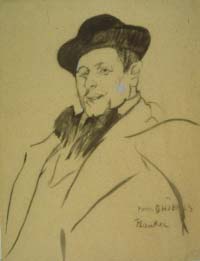
|
|
| HENRI-GABRIEL IBELS--This powerful portrait sketch by Henri de Toulouse-Lautrec is on loan to the Frick from Smith College | |
Obviously, that's not the case—not only because both Smith's and Cleveland's archives have been forming for years—but also because any of these artists, past or present, any curator would love to add to a major collection.
And why does Smith College have such a fine assortment of masterworks of drawing & sketching?
Originally, Smith was founded—through the will of Sophia Smith—to educate young women. A cornerstone of this training was Useful & Fine Arts, exemplified in drawing from paintings & sculptures by the Masters. Great sketches & prints by great artists proved challenging models.
Collection for largely educational purposes gradually gave way to acquisition of great drawings for their own merits.
El Greco Refines Two Potent Images:
St. Jerome & Money-Changers Versions at Frick
[Closing July 29, 2001]
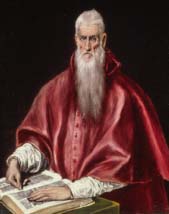
|
|
| ST. JEROME AS A SCHOLAR--This lustrous portrait is one of three of El Greco's Jeromes currently at the Frick, on loan from the Met Museum. | |
With Henry Clay Frick's prized rooms, antique furniture, richly woven hangings, thick carpets, priceless paintings, & sleek sculptures in place, there is little free space on the main floor for other displays.
Fortunately, the oval room between the long gallery and a square chamber does offer an ideal venue for highlighting selected major artworks. A small show focused on Velázquez prepared the way for another.
But "El Greco: Themes & Variations" is far more powerful. It consists of only seven paintings by the Cretan-Venetian-Spanish Master. Three of them are magisterial portraits of Saint Jerome.
Arguably, the Frick's own "St. Jerome" is the most powerful. But some would insist that "Saint Jerome as a Scholar"—on loan from the Met—is even more potent. But then there's the third powerful portrait: the "St. Jerome" from the Varez Fisa Collection in Madrid.
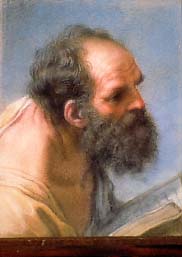
|
|
| HEAD OF AN APOSTLE--Benedetto Luti's pastel sketch is part of the Smith College show at the Frick | |
The only other El Greco Theme on view is his changing vision of "Christ Driving the Money Changers from the Temple."
The painting which bears this actual title belongs to the Minneapolis Institute of Arts. It is rather different from the other three versions of this legendary scene.
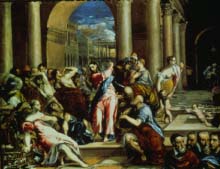
|
|
| MONEY-CHANGERS & FAMOUS PAINTERS--El Greco included a panel of four painter-portraits in this version of "Christ Driving the Money Changers from the Temple," on loan to the Frick from Minneapolis. | |
Looking from right to left, down in the left corner—like a picture-within-a-picture—are the faces of four artists El Greco admired. The faces are those of Titian, Michelangelo, Guilio Clovio, and possibly Raphael.
Both the Frick's version and that on loan from Madrid are titled "Purification of the Temple." The version from the Kress Collection at the National Gallery in Washington is called "Christ Cleansing the Temple."
Seldom did painters of El Greco's time repeat a subject, but he not only did so, but also spread his experiments with the same theme or subject over the years, revealing the evolution of his style & vision.
Even today, El Greco's bold brush-strokes and luminous use of bold colors seem very modern. His unusual vision and his distinctive technical mastery have been viewed as precursors of Cezanne and the Post-Impressionists.

|
|
| A VERMEER NOT IN THE MET MUSEUM'S CURRENT SHOW--None of the Frick Collection's Vermeers can be shown elsewhere: This is "Officer & Laughing Girl." | |
The Frick Vermeer That Cannot Leave Home:
Officer & Laughing Girl Can't Make Merry at Met
[On permanent exhibition]
It may seem odd that the Met can loan the Frick an El Greco, but the Frick cannot return the favor with the loan of a Vermeer for the current wide-ranging Vermeer exhibition now on view at the Metropolitan.
The Frick did loan the Met its lovely Ingres portrait recently for a show of Ingres' works in portraiture. But Henry Clay Frick did not want his priceless Vermeer—Officer & Laughing Girl—to travel. Not even 14 blocks up Fifth Avenue.
So the Frick is highlighting this charming, suggestive picture of a cavalier and a friendly young woman in a left-lit Dutch chamber. It is an effective pendant to the Met's handsomely mounted show.
Old Fossils for Young Explorers!
Hands-On Environmental Experiences
In New "Discovery Room" at American Museum
[Permanent Installation]
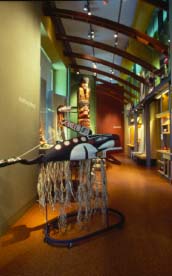
| |
| TOTEMS & TABOOS--Hands-on in the new Discovery Room of the American Museum of Natural History! Photo: ©J. Beckett/AMNH/2001. | |
Those who have bought souvenirs & toy dinosaurs in the American Museum of Natural History's ground-floor shop on 77th Street will be surprised to discover that this awkward space has been redecorated, re-outfitted, and reformed into "The Discovery Room."
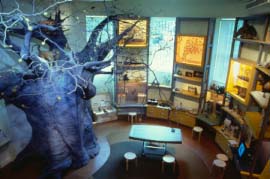
|
|
| BIG TREE & BIODIVERSITY--Young people learn about the environment in this section of AMNH's new Discovery Room. Photo: ©J. Beckett/AMNH/2001. | |
What made it an awkward space as a shop works to its advantage as a hands-on exploratory center for kids and teens. What were once cubby-holes or cul-de-sacs are now specially designed areas devoted to different aspects of science & the environment.
The major downstairs areas are devoted to Biodiversity, Anthropology, & Paleontology. On the mezzanine, there are labs for Seismology, Microscopes, & Astronomy, plus a Resource Room.
Not only can kids hunt for hidden creatures in an immense reconstruction of an African Baobab tree, but they can also help assemble the skeleton of the Prestosuchus—which does sound very much like a jokey name: Presto-Such-As?
There's a towering Kwakiutl totem-pole made especially for the American Museum. The Kwakiutl are the Potlatch People: Give a party which will bankrupt your rival when he tries to match your generosity to your guests.
President Bush might want to try this on Russia or China—instead of a hostile missile-shield?
The Genomic Revolution at AMNH
[Closing January 1, 2002]
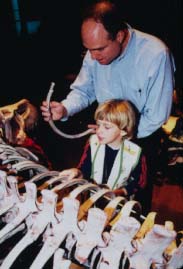
|
|
| THIS IS NOT A XYLOPHONE! --Inspecting a Triassic fossil skeleton in the Discovery Room at the American Museum of Natural History. Photo: ©M. Carlough/AMNH/2001. | |
Everybody's talking about Genomes, but most don't know what they are—or what they are talking about either.
The new exhibition at the American Museum explains in detail what the new revelations in molecular biology have achieved already. And where such discoveries may lead scientists in healing and evolving species.
Some religious leaders—and of course their followers—are opposed to research and experiments which might in any way tamper with human, animal, or plant development. Some politicians have opportunistically taken their vote-getting cue from these attitudes & pronouncements.
The new thought-provoking installation at AMNH should do much to dispel fears about scientific progress in genome research.
"Print, Power & Persuasion" at Bard Center:
Stunning German Graphic Design To 1945
[Closing August 26, 2001]
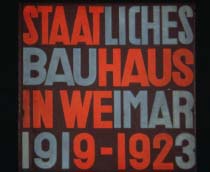
|
|
| DOWN WITH GOTHIC TYPEFACES!--Herbert Bayer's stunningly simple modern cover for Bauhaus catalogue now on view at Bard Center. Photo: ©Bruce White/BGCSDA/2001. | |
While the current show of powerful graphic designs at the Bard Grad Center is limited to Germany, at least one of the artists represented—Joseph Maria Olbrich—was Austrian.

|
|
| GERMAN STONE-THROWER--Teutonic Athlete in Hans Treiber's Jugendstil drawing for 1913 Turnfest in Leipzig, shown at Bard. | |
In fact, it could be insisted that the impetus for truly modern design in the decorative arts & architecture—called Jugendstil—originated in Vienna. Artist-designers such as Otto Wagner, Kolo Moser, & Olbrich created amazingly modern designs at the dawn of the 20th century. Some of their flatware, fabrics, and posters are as streamlined as Art Deco. Even if Jugendstil is really the titular equivalent of the distinctly dated turn-of-the-century French Art Nouveau.
Although the focus is largely on high-impact poster-art, advertising, book-covers, typography, & packaging, other applications of the graphic arts are represented.
There are also some actual objects—including furniture—which show this design-style in three-dimensional & practical manifestations. As the Germans say: Angewandte Kunst, or Applied Arts.
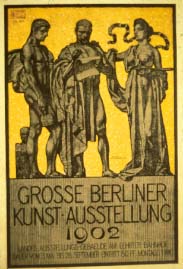
|
|
| ELEGANT ALLEGORICALS NOT GROSS! --T. Lucius' Jugendstil image for the 1902 Grosse Kunst-Austellung in Ber in Bard Center's "Graphic Design in Germany" exhibition. Photo: ©Peter Harholdt/BGCSDA/2001. | |
The Bauhaus in Weimar—and later in Dessau & Berlin—was noted for its Jugendstil creations. As was Vienna's famed Wiener Werkstätte.
The current exhibition has been selected from the holdings of the Wolfsonian Museum in Miami's South Beach. The credits name its parent-body as The Wolfsonian-Florida International University.
Having toured the museum's strangely sited objects—in an even more awkward space—I have to admit that Mr. Wolfsohn has acquired some neat things. Some of which you can see at the Bard Center.
Mies in Berlin at MoMA
[Closing September 11, 2001]It's a long long time to Oktoberfest, but German art & architecture seems to be preparing the way. One of the most important and influential of modern architects—Mies van der Rohe—made his mark initially in Germany.

|
|
| PERLS HAUS A PEARL OF A HOUSE-- Ludwig Mies van der Rohe's impressive Berlin Villa. Photo: ©Kay Fingerle/MoMA Archive. | |
Thanks to the rise of Adolf Hitler and the resultant tyranny of the Nazis, Mies had two careers: One in Germany; the second in America.
MoMA is currently examining the First Career in detail—including digital detail, with manipulated photos. There are also newly constructed models of some of Mies' most ingenious German projects.
Some 47 pre-World War II European projects are on view at MoMA. They are explicated by 288 drawings, 14 scale-models, photos, and relevant artworks & films.
Among them are the Perls House, the unbuilt Kröller-Müller Villa, his own Tugendhat House, and the famous German Pavilion for the Barcelona World's Fair of 1928. The latter has been reconstructed on its original site in the Catalan capital.
Mies in America at Whitney
[Closing September 23, 2001]
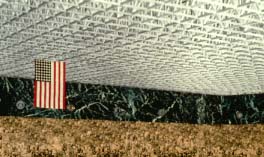
|
|
| PUT OUT MORE FLAGS!--Mies van der Rohe's "Collage for the Chicago Convention Hall" on view at the Whitney. Photo: ©MoMA Archive. | |
When Mies emigrated to America in 1938, he established himself in Chicago. The Whitney complement to the MoMA exhibition continues his design development until his death in 1969,
This show presents 220 drawings by Mies and his staff, along with some 60 photos of projects, colleagues, and the Master Himself.
There are impressive models of four major Mies Projects: The Chicago Convention Hall, the Resor House, Manhattan's Seagram Building, and Berlin's New National Gallery.
Artworks and books relevant to Mies van der Rohe's evolution as an architect in America—where he adapted New World technology to his Old World Modernism—will also be on view.
Uptown Guggenheim Frankly Salutes Successor:
"Frank Ghery, Architect"
At Frank Lloyd Wright Venue on Fifth
Foreshadows Frank Ghery on East River—
[Closing August 26, 2001]
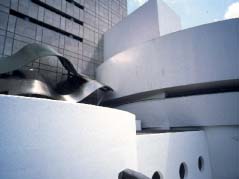
|
|
| GHERY GUGGENHEIM UPTOWN--Architect Frank Ghery offers a preview of his style for the proposed East River Guggenheim, tacked onto Frank Lloyd Wright's Fifth Avenue Masterpiece. Photo: ©Ellen Labenski/SRGF/2001. | |
By the time you read this, the Guggenheim's Frank Ghery retrospective should be fully visible. But—even after its formal opening—the great suspended swaths of aluminum mesh designed to hang from the top of the Frank Lloyd Wright Rotunda were not yet secured in place.
This is an amazing show, with models & sketches of Ghery's earliest projects through his proposal for a shiny new titanium-decorated Guggenheim on the East River. If the touristic & cultural success of his remarkable museum for Bilbao is any measure, the new Guggenheim should do wonders for the Lower East Side & South Street Seaport.
Before Ghery created the voluptuous Spanish exhibition venue, few had heard of Bilbao—except in a Brecht/Weill song. And even fewer found any reason to go there, with the continuing unrest among Basque Separatist Terrorists.
The Bilbao Ghery has changed all that, making the city a tourist-mecca, with a tremendous economic "trickle-down" effect.
New York City isn't exactly on the ropes economically or culturally, but the proposed East River Extravagance should do much to re-animate interest in one of Manhattan's less attractive areas.
Some of the models for other projects in the current show—as do the models for the East River site—reveal Ghery's dependence on the often amazing, even outrageous, manipulation of great bands or swaths of gleaming titanium metal for the effect of novelty and architectural innovation.
Behind and under these flamboyances, however, lurk the blocks of conventional architecture. An open-air concert-venue, for instance, is perfectly—even necessarily—conventional in its seating & stage. Only its canopy proclaims it a wildly joyous Ghery architectural sculpture.
Ghery does, however, also manipulate the conventional forms of buildings. The Bilbao Museum—like Daniel Libeskind's Berlin Jewish Museum—is in itself an external & internal sculpture. It would be worth the visit for its forms alone.
His projects for the new New York Times Building—to be sited on Eighth Avenue, between 41st & 42nd Streets, but not by Ghery—show versions of a spirally twisted high-rise.
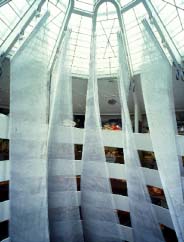
|
|
| MESHES CASCADE IN WRIGHT ROTUNDA-- Unusual centerpiece of current Frank Ghery restrospective at the Guggenheim Museum. Photo: ©Ellen Labenski/SRGF/2001. | |
But his Nationale-Nederlanden Building in Prague—snuggled up against a thoroughly conventional 19th century structure—looks like two already over-windowed cylinders, seen in distorting Fun House mirrors. Behind them, however, the layout is more sedate.
Ghery's contribution to Germany's Vitra Design Museum—with other architects also creating trend-setting structures—presents new volumes and forms, created in the 1980s. The new Disney Concert Hall—now under construction in the Los Angeles Music Center Complex—promises to be even more impressive externally. Disney's Michael Eisner has a thing for cutting-edge architecture.
If you can remember when Ghery's novel chairs—made out of layers of corrugated cardboard—first appeared [1969-1973], now you can see for yourself how well they've survived the years.
Ghery's experiments with Colorcore—a translucent plastic laminate—produced the Snake & Fish Lamps. Those who bought them now have vastly increased their initial investment. They also have some of Post-Modernism's most handsome, intriguing, and eminently functional sculptures.
Then there are Ghery's furniture designs for Knoll: the Bent Wood Furniture Collection. He went far far beyond Thonet's once modern bentwood chairs & chaises.
National Steinbeck Center in Salinas:
Preparing for Nobel Prize-Winner's Centenary
[Permanent Installation]
More copies of John Steinbeck's novels are sold in his home-town of Salinas than by Barnes & Noble and Amazon.com combined!
They are on sale in the gift-shop of the National Steinbeck Center, a handsome Post-Modernist complex at the apex of the Historical Landmarked downtown area of this thriving California town, the Heart of Steinbeck's "Long Valley."
Perhaps these impressive sales-records are owing to the magic for literary tourists of actually being in the Salinas Valley. And to visiting the sites of some of his most famous works: Books like The Red Pony, The Pastures of Heaven, To a God Unknown, In Dubious Battle, Of Mice and Men, The Grapes of Wrath, Tortilla Flat, Cannery Row, & East of Eden.
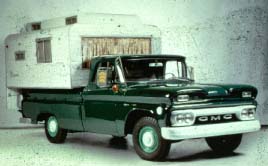
|
|
| ON THE ROAD WITH JOHN STEINBECK! --Nobel Prize-winner's camper "Rocinante"-used to research "Travels with Charlie"-now in Steinbeck Museum in Salinas, CA. Photo: ©NatSteinbeckCtr/2001. | |
But this surge in book-buying could well be inspired by a walk-through of the ingeniously designed and visualized Steinbeck installation. Here, one can trace Steinbeck's life & career—with photos, videos, and reconstructions along the way—to evoke the literary works created over his long, productive life.
Although this interactive exhibition is in a somewhat confined space, it is so cleverly designed—like a maze in which you cannot lose your way—that nothing seems left out. Including film-posters for Steinbeck novels, and films which Steinbeck wrote himself, such as Viva, Zapata! and Alfred Hitchcock's Lifeboat.
Recently, the National Steinbeck Center had a special show on Steinbeck in Hollywood, complete with impressive foreign-language movie-posters—when films based on his novels or scripted by Steinbeck were distributed worldwide.
There is also a special film-theatre for a Steinbeck Orientation, as well as an extensive Steinbeck Archive. There is even a special room for school-children, where they can learn more about their town's Most Famous Son. Or try their own hands at writing about Salinas, the Valley, or even their own innermost thoughts.
Among the Steinbeck artifacts in the interactive installation is the actual camper—Rocinante, named after Don Quixote's quixotic steed—in which he and his dog drove round the United States, gathering material for Travels With Charlie.
This August the annual Steinbeck Festival will be especially impressive, for the Centenary of John Steinbeck begins January l, 2002. Such topics as "Steinbeck at Stanford" and "Steinbeck's Women Teachers" are scheduled.
As well as a tour of the Red Pony Ranch, closed to the public the rest of the year. Visits to Steinbeck sites in Pacific Grove—the family summer home is still unmarked!—and Monterey are also on the program.
In late June, I photographed many of these sites for a presentation at the Opera Workshop at the Bregenz Festival in Western Austria. Carlisle Floyd's opera, Of Mice and Men, based on Steinbeck's novel, will be premiered, with Floyd on hand.
I plan to familiarize those opera-loving Europeans who join the workshop with some wonderful & historic California sites which are so much a part of Steinbeck's heritage as a writer. And I hope I may inspire some to make the Pilgrimage to Salinas & Monterey in 2002.
It would also be gratifying if Austrian TV became interested in producing a special Steinbeck Documentary for the Centennial!
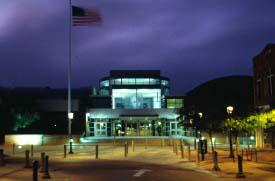
|
|
| CELEBRATING STEINBECK & SALINAS!--Handsome new National Steinbeck Center is ready for beloved author's Centenary in 2002. Photo: ©Stuart Schwartz/NatSteinbeckCtr/2001. | |
In the process of selecting sites to photograph, I discovered a number of relationships between Steinbeck and myself—even though he was born in 1902 and I in 1928.
We both went to Stanford. We both had the same literary agent: Elizabeth Otis. In our teens, we both worked as rod & chain-men on County Surveyors' crews. We both toiled alongside migrant workers. Steinbeck house-sat winters at Lake Tahoe; summers, I was fixing up our cabin by the lake. Characters in East of Eden were well-known to my mother & cousins, who grew up in Salinas.
In the Salinas Odd Fellows' Cemetery, John Steinbeck is buried in his mother's Hamilton Family plot. He's not far from the graves of my Abbott cousins—one of whom appears in Steinbeck fictions as the sheriff who keeps an eye on Mme. Flora's House and various carefree Monterey characters.
If you cannot get out to Salinas in 2002, Steinbeck will come to you—if you are a New Yorker. Special exhibitions are planned at Columbia University, the CUNY Grad Center, the Morgan Library, the Brooklyn Public Library, the Mercantile Library, and Hofstra University.
Failing the opportunity to go West or East, re-read Steinbeck's novels at home!
[Loney]
Copyright © Glenn Loney 2001. No re-publication or broadcast use without proper credit of authorship. Suggested credit line: "Glenn Loney, Curator's Choice." Reproduction rights please contact: jslaff@nymuseums.com.